#richelieu lace
Photo

La Mode nationale, no. 327, 30 juillet 1892, Paris. No. 2. Carré en guipure richelieu. Bibliothèque nationale de France
#La Mode nationale#19th century#1800s#1890s#1892#periodical#fashion#pattern#guipure#richelieu#lace#Bibliothèque nationale de France
27 notes
·
View notes
Text
Not to end on the stan part of enjoying someone’s social media presence but following corpsegrinder on ig has been one of the better decisions. He’s such a great and proud dad and so geek about the whole plush toy thing. A delight to follow, truly
#cannibal corpse#tomb of the mutilated circled in my ears half of the time#i’ve been having extremely bad weeks lately and he just warms my cold dead heart#cannibal corpse took me out from being desperate about the craft part of my entrance exams#insomnia spike plus the disappointment from how the whole thing was handled is just 👌👌#months of prepairs and all for nothing#could fucking go to the exams with a few lousy drawings in a dirty mappe#two and a half hour for a still life made out of different shades of muted greys and greens#embroidery on a fucking burlap sack cloth or what that shit was like sorry i can’t work with that material#I’m glad that i prepared for richelieu embroidery and needle lace level and get to do crossstitch on a potato sack#amd then the teachers have the audacity ti complain about the quality of the work the students do#watch me fail the exams because the bar is literally in the ditch and i can’t get my head around it#personal#tbd
0 notes
Text
RESTAIURO E MANUTENZIONE TESSILE - su lenzuolo nuziale metà secolo 800
Restauro conservativo su lenzuolo nuziale in lino d'Olanda / forestiero, metà sec. 800 ricamo Richelieu - intaglio - punto pisano - punto inglese : riaggancio barrette e bloccaggio lisatura, lavaggio e apprettatura con amido vegetale
Restauro conservativo su lenzuolo nuziale in lino d’Olanda / forestiero, metà sec. 800 ricamo Richelieu – intaglio – punto pisano – punto inglese : riaggancio barrette e bloccaggio lisatura, lavaggio e apprettatura con amido vegetale

View On WordPress
#alessandra restelli#antique laces#embrodery#intaglio#kartika980#la camelia collezioni#la camelia collezioni vigevano#lavaggio corredi#lino d&039;olanda#manutenzione tessile#punto inglese#punto pisano#restauro conservativo#restauro lenzuola#restauro tessile#ricamo richelieu#smacchiatura copriletti antichi#smacchiatura lenzuola antiche#stiratura corredi
0 notes
Note
Would you put Louis XIV as overrated?
Oof, that's a tough one.
It's particularly hard to answer because the reign of the Sun King also saw the tenure of some of the most influential chief ministers in French history: Mazarin, and Colbert.

While perhaps not quite as famous as a certain cardinal whose schemes kept getting foiled by the Three Musketeers, these guys were world-historically important.
Mazarin was Richelieu's political heir, and brought his predecessor's policy of using the Thirty Years War as a way to break the back of Hapsburg dominance to a successful conclusion. The Peace of Westphalia not only served as the foundation for modern international relations, but also expanded France's position in Alsace and the Rhineland - especially when Mazarin pulled off an anti-Hapsburg alliance with the new League of the Rhine.
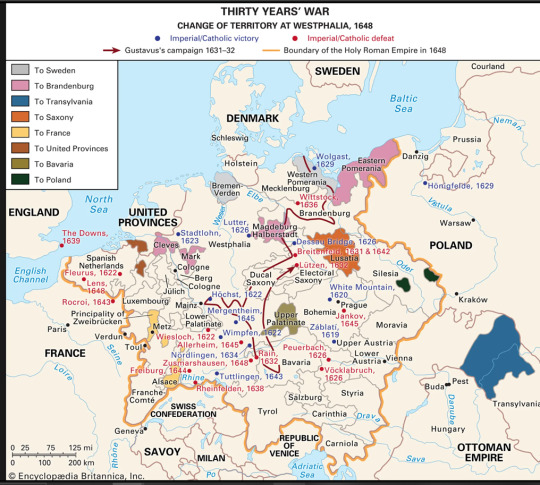
At the same time that France was winning the Franco-Spanish War, which won them a big chunk of territory in the Low Countries around Artois, Luxembourg, and parts of Flanders, and all of the territory north of the Pyrenees Mountains including French Catalonia. It also got Louis XIV the hand of Maria Teresa, which would eventually create the catalyst for the War of Spanish Succession and the War of Austrian Succession...
And while Mazarin was doing all of this, he was also busy crushing the Fronde uprising led by le Grand Condé, which he eventually accomplished in 1653, and creating a formidble system of centralized royal government through the intendants that ended the power of the feudal nobility.

As for Colbert, he was the guy who figured out how to pay for all of this. The single biggest reason why economists need to shut the fuck up when they talk about mercantilism, Colbert was the financial and economic genius of his age. Remember all those canals I'm so crazy about? Colbert built them. Specifically, he was responsible for the Canal des Deux Mers, transforming France's economy by linking the Mediterranean to the Atlantic.

He also turbo-charged France's economic development by restructing public debt to reduce interest payments and cracking down on tax farmers, reforming (although not ultimately solving) the taxation system of the Ancien Régime by using indirect taxes to get around tax evasion by the First and Second Estate, equalizing (but not ending) internal customs duties, and putting the power of the state into supporting French commerce and manufacturing. This included significant tariffs to support domestic producers, direct public investments into lace and silk manufacturing, and the creation of joint-stock corporations like the French East India Company. (This also meant Colbert's direct promotion of the slave trade and the Code Noir in order to generate hugely profitable investments in Haitian sugar and tobacco plantations for import into France and the rest of Europe.)
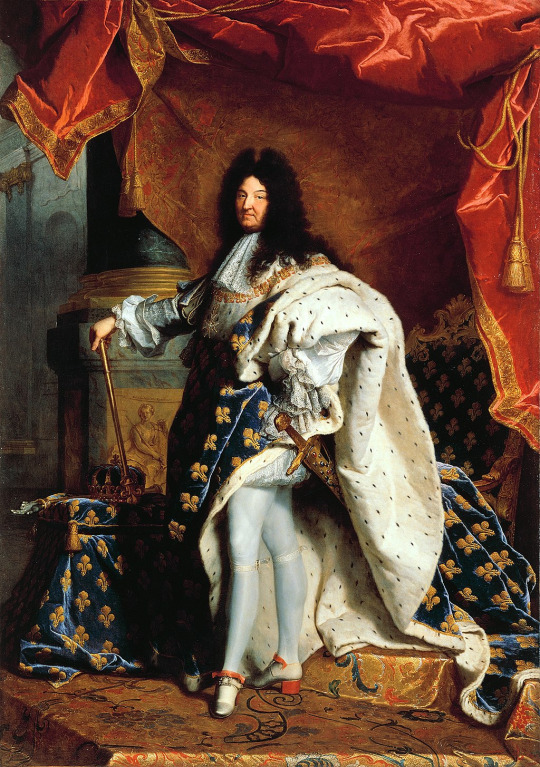
This makes it a little difficult to separate out what credit belongs to these guys versus the guy who hired them. What I can say is that Louis was directly responsible for Versailles, but also for the revocation of the Edict of Nantes.
#history#historical analysis#cardinal richelieu#cardinal mazarin#jean baptise colbert#louis xiv#versailles#french history#early modern history#economic development#mercantilism#political economy#early modern state-building#early modern period#early modern europe
29 notes
·
View notes
Text
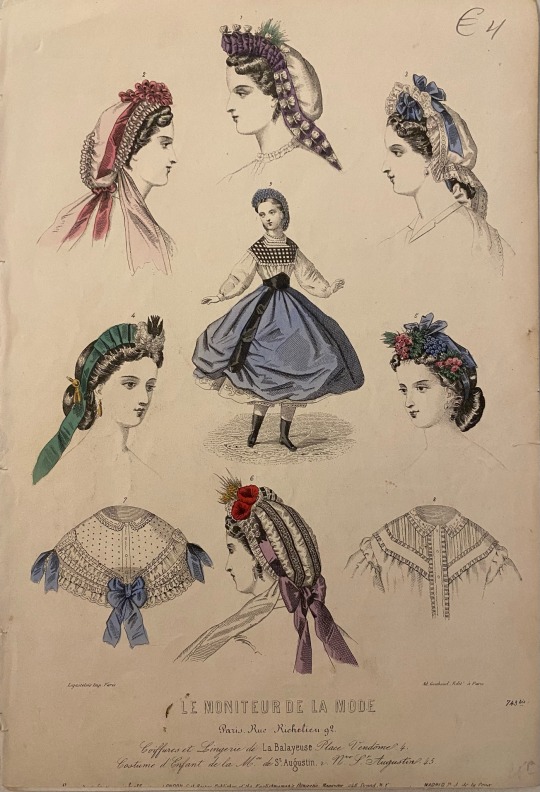
A French fashion plate circa 1860 advertising bonnets, lingerie, and a child’s outfit. Purchased in Amsterdam. It appears to be an original print torn from a catalog published in London. The items are numbered 1 through 9. The text reads:
Legastelois Imp. Paris Ad. Goubaud, Edit’ à Paris
LE MONITEUR DE LA MODE 743^bis
Paris, Rue Richelieu 92
Coiffeurs et Lingerie de La Balayeuse, Place Vendôme, 4.
Costume d’Enfant de la Mon. De st. Augustin. r. Nve. L. Augustin, 45.
The legible portion of text at the bottom of the page reads:
(Illegible) LONDON (illegible) publisher of the Englishman’s Domestic Magazine, 248, Strand, WC. MADRID P. J. De la Pena
Here is an English translation. My translations of the abbreviations may not be completely accurate:
Legastelois Printers (or Printing), Paris.
Ad. Goubaud, edited in Paris.
THE MONITOR OF FASHIONS
92 Richelieu street, Paris
Hairpieces and lingerie by (of) The Sweeper, 4 Vendôme Place.
Child’s costume by (of) Mr. Saint Augustin, 45 Nve. L. Augustin street.
I cannot tell what Bis and Nve stand for.
[Image ID: all of the colors on this print are the same shade. For example, the purple ribbons on images one and six are printed with the same color of ink. IDs are Clock wise from the top, which is why the numbers are out of order.
#1: White bonnet trimmed in wide purple ribbon which is ruched or pleated above the brow and decorated with white butterflies and green grass. The ribbon trails down the wearer’s back.
#3: White bonnet trimmed with white lace with circular eyelet patterns and a light blue ribbon which forms a multi-looped bow on each side of the lace at the center of the brow. The lace trails down the wearer’s back.
#5: Light blue ribbon hair piece with a central bow, trimmed with light blue berries, small, dual colored roses of pink and light pink, and small green leaves.
#8: The upper half of a white chemise or corset cover with a small lace collar trimmed with thin ruched or pleated ribbon. The yoke is triangular with a thin, vertical lace or pleated pattern. This yoke is bordered by a wide ribbon trimmed with pleats, and the same decorates the button band down the center. The arm scyes (I do not know how to spell that word, please leave a comment educating me) are dropped with a ruched section before the sleeve begins.
#6: White bonnet with two pieces of black lace running vertically down the center back, with a purple ribbon tied in a large central bow along the bottom edge. The front and side edges are trimmed in ruched lace, decorated with two large red poppies and yellow wheat. The ribbon trails down the wearer’s back.
#7: I believe this image is a corset cover. It is in the shape of a diamond yoke and looks like a small cape for the chest, back, and shoulders. The garment is white. The collar is thin and trimmed in ruched ribbon, beneath which is a large triangular section of dotted lace or fabric. Triangular, lace-fringed epaulettes with light blue ribbon bows at the bottom sit low on the shoulders. The bottom edge of the garment is trimmed in a layer of wide ruched ribbon with a ruching and eyelet border, followed by two layers of scalloped ruched lace with eyelets. At the bottom center is a large, double bow of light blue ribbon.
#4: Green ribbon hair piece with box pleats above the brow. At the center is an ornament of a cloud with a small, dark bird driving downwards. The ribbon trails down the wearer’s back. The piece is styled with a yellow hair pin and matching tear drop earrings.
#2: Light pink bonnet trimmed with center-ruched ribbon along the edge and half way up the center back. Two long, wide, light pink ribbons trail down the wearer’s back. The center bottom edge is decorated with a small, dark pink bow with long ribbons. The center top is decorated with a pile of dark pink loops of ribbon, with an additional dark pink ribbon trailing to the bottom edge.
#9: The central figure, a preteen girl. She wears a light blue snood with center-ruched ribbon on the head band, a pearl necklace, and black boots. Her outfit is a white bodice with cuffed peasant or bishop sleeves and a large, black and white gingham yoke. Her skirt is light blue, wide, and falls to just below the knee. It has a wide black belt pointed at center front top and bottom, with a single, descending black ribbon which asymmetrically and slightly raises the skirt to reveal a petticoat with an abstract floral border. End ID]
I absolutely adore this print. If you know what sort of garment #7 is, please comment to let me know. The large bows seem impractical for a corset cover. The most remarkable aspect of this page is the girl’s dress, which features the only asymmetric skirt I have ever encountered in a primary source. The shape of skirt suggests the early and middle 1860s, when this layering of skirts was not yet popular, but because children rarely wore cage crinolines it could also be from the end of the decade. I was very lucky to find this and some other prints at a street vendor who claimed they were originals.
Let me know if you know anything about determining if a print is an original, or if you have seen this print before or know of other examples of asymmetric skirts. Or, of course, if you know these French abbreviations. I am not a native speaker.
#fashion#fashion history#victorian fashion#antique#fashion plate#french fashion#image#itsgonnacostsomuchtoframeallthese
56 notes
·
View notes
Text
Thursday 7 June 1838
8
11 50
very fine morning – Carré (coiffeur) at 8 ½ as yesterday – breakfast at about 10 – F66° at 9 am dressed – ready at 11 – took the 2 servants, and Lefevre, laquais de place, 1st time and off at 11 40 in landau to St. Cloud by the avenue Charles X thro’ the bois de Boulogne – at the palace at 12 35 – the royal family to be there today .:. could not see the interior of the palace – alighted – walked about – went to the top of the observatory and to see the cascade and got into the carriage again at 1 40 – en passant called on Madame de Bourke no.53 r. du faubourg St. Honoré – very glad to see me – but almost immediately came the duchess of something and her 2 daughters and a gentleman the d....... I suppose and I took my leave – Madame de B- said there was a letter for me, and shewed me to Miss Gassy who gave me the note from Miss Ferrall and gave me an address to a dressmaker and to a carossier letter of horses and carriages and on hearing of my going to St. Sauveur, said she would give me letters (she is from near Tarbes) si cela ferait plaisir – thanked her and said yes – A- had waited for me in the carriage – then to the bank (Ferrère Laffittes’) and exchanged at 25/40 two circulars numerous 4921 and 4922 – they looked at their books from 1831 and my Paris (ill dated) plate had never passed thro’ their hands at all from that time to this! then to the passage des panoramas and bought rebounds and came away at 3 50 – then to R. de Richelieu no.40 [Bonhorne] Steiger and ordered 2 pair gaiters 1 pair for A- 1 pair for me hers to lace mine to button, to come on Sunday at 9 am – then to Madame Contant
SH:7/ML/E/21/0118
and ordered mantelet for A- and shawl for myself (same étoffe black silk) with black lace at 6/50 l’aune = 8 aunes for me – same for A- to go to Madame C- at 1 or after tomorrow and to have shawl and mantelet and French cachemere [cashmere] shawls for A- to look at etc. – then to Wallrands’ for note-paper etc. Rue de la paix – she mentioned an apartment to be let for 300 for 1 month 500/. for 2 months and 700/. for 3 months in r. d’Aujon – very good apartment and well furnished plenty of room for us – and knows of man and woman servant married and ditto man single – said I would apply to her for an apartment another time before my arrival – but this was said un peu légèrement – not likely to be acted upon off from Wallrands’ at 5 ¼ - then to Houbigant for toothbrushes for A- and pomatum for us both - and then to Madame Figarols’ for a minute or 2 - home at about 5 ¾ - Oddy and George who had left the carriage at Madame de Bourkes’ door to come home to luncheon and then go to the coiffeur, could not find the way! – dawdling over 1 thing or other with A- till dinner at 7 – then after 8 had the ladys’ maid (a Swisse from Neuchatel) recommended by Madame Figarol – she would not take less than 400 or 500 fr. a year – she did not make less at Madame de (comtesse de) [Pourpris’] she had lived with an English woman aetatis 40 (serious – pious) before coming to Paris 8 years ago – thought she should not be dull in England – liked gaiety, but did not see it – said I would let her know in a day or 2 whether I thought of engaging her or not – just went out to Oddy for a minute and found A- (at 9) going into bed – poorly all today – my note from Miss Ferrall (vid. last p. of this volume) affectionate and kind for all of them (the Bluchers’) – much pleased with my letter tho’ afraid I should not think so from the time she had been in answering it – her note dated May 1837 – Mr. de Hagemann not happy tho’ he had got [they] the princes had refused his invitation to dinner and de H- now wished he had not acted so foolishly they are all sorry for Lady Harrietts’ sake – A- is terrible what shall I do with her I might as well have a millstone tied round my neck I must men this some way go to the Pyrenees and to Montpellier and see how I can live there – had just written so far at 10 pm fine day tho’ rain-threatening a few drops as we returned home near to Paris – I have just given her the last of our cherry brandy I perpetually think of Stephen’s that I should have a deal of rouble with her he was very right but I will be off some way or other – Had Oddy - at accounts – till now 11 10 pm F66° at 11 20 pm
2 notes
·
View notes
Text
Brazil 🇧🇷
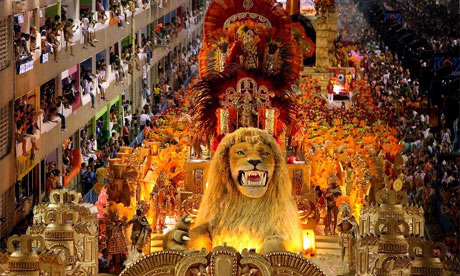
Tradition
Carnaval is a wild celebration of food, alcohol, music and fun. It's held annually for a few days before the start of Lent, the 40-day period of fasting, abstinence and repentance that's observed by the Roman Catholic Church before Easter. The word carnival comes from the Latin carne vale, or "farewell to the flesh"
The Portuguese brought the practice of Carnival to Brazil around 1850, patterning it mainly on the Parisian tradition of holding masquerade parties and balls at this time of the year. However, the Brazilians morphed it into a version uniquely their own over time, adding in elements from the people's African and indigenous cultural backgrounds.

Thus, Carnival in Brazil eventually incorporated lots of parades, elaborate costumes, music, dancing and balls. A tradition also developed where people dress up in opposing roles: men dress as women, aristocrats dress as commoners, the poor dress as the rich.
Carnival is held all over the country; celebrations differ a bit by region, but Rio de Janeiro's celebration is the most popular, drawing crowds of 500,000 foreigners annually from across the globe.
While all Brazilians love Carnival, the black communities are its most avid participants. This likely stems from the community's historical love of Carnival, as African slaves were freed annually for the festival's duration.
Traditional outfits

People wear the same types of clothes in many places of the world. Jeans and T-shirts are worn in most countries, replacing traditional garments. But for special occasions or celebrations, some people choose to bring back the memories of the past by wearing a traditional costume. While they don't wear it every day, Brazilians care about their traditional clothing and wear it for different occasions, such as carnivals or national celebrations.
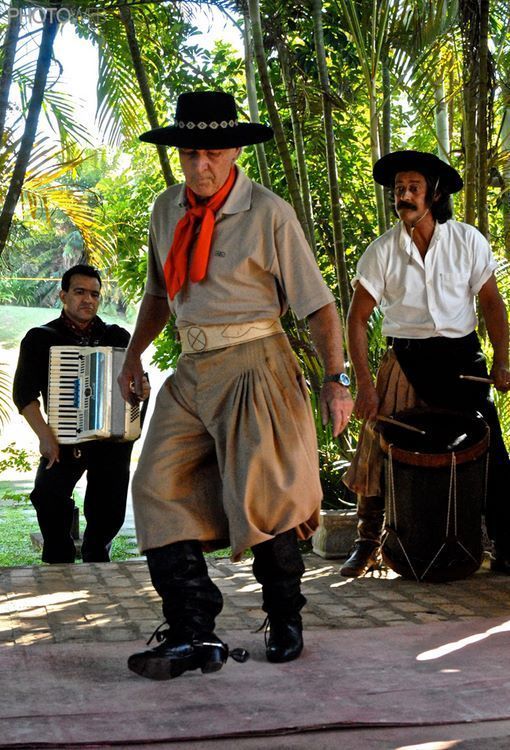
In general, Brazilians wear clothing that's comfortable yet richly colored and sophisticated. However, there are some preferred clothing types depending on region.
For example, those living in the southern plains, a ranching area, wear gaucho-type clothing: baggy pants, or bombachas; cowboy hats and cowboy boots.

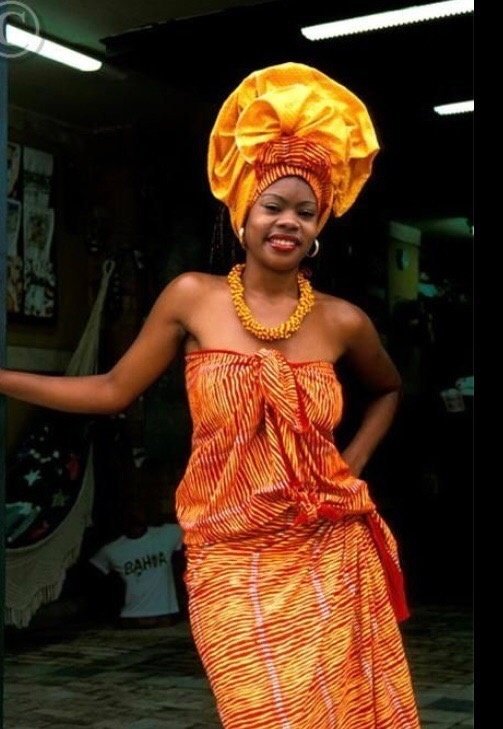
People in the country's northeastern Bahia region, which is heavily influenced by African culture, don long skirts, head scarves and shawls. Items adorned with bordado richelieu -- a type of lace developed in 18th-century France to mimic white Venetian lace, which was brought to Brazil by the Portuguese -- are also popular
Another way to consider Brazilian clothing is country attire versus city attire. Those who live in the country tend to wear shirts, jeans or dresses crafted from an inexpensive cotton material. Women who reside in the city often like to wear short skirts and dresses, and both sexes of city slickers enjoy that most typical of Western attire: T-shirts and jeans.
Statue of Christ the Redeemer.


Towering 2,310 feet above the city of Rio, the Christ the Redeemer statue has fascinated experts and historians for nearly a hundred years.
This landmark is must-see in any visit or free tour around Rio, and for good reasons! It’s the fourth largest statue of Jesus Christ in the world, the largest Art Deco-style sculpture on the planet, and to top it all off, in 2007 the statue was deemed as one of the New Seven Wonders of the World along with Machu Picchu, the Great Wall of China and the Roman Colosseum.
Perched on the summit of Mount Corcovado in Rio, the statue stands at a whopping 98 feet (or 30 metres) tall (making it two-thirds the height of New York’s Statue of Liberty), and its outstretched arms reach to 92 feet (or 28 metres) horizontally.
The idea of designing a massive statue of Jesus Christ in Rio first came about way back in the 1850s, when a local priest came up with the idea of placing a Christian monument on top of Mount Corcovado. Apparently he had requested Princess Isabel (the daughter of Emperor Pedro II and Princess Regent of Brazil at the time), to fund the project, but the idea was scrapped after a Declaration of the Republic was declared in Brazil in 1889 – a pinnacle move as it separated the church from the state in the country.
Traditional food

Feijoada.- Brazilian Feijoada is a black bean and pork stew that Brazilians often serve topped with farofa, toasted cassava flour. Many call this comfort food the national dish of Brazil.
Feijoada, a popular Brazilian dish, owes its name to its main ingredient, black beans (feijão). It is a rich stew traditionally made from different parts of the pig, such as feet, ears, and bacon, as well as other smoked meats.

Farofa.- farofa is particularly popular, typical recipes call for raw cassava flour to be toasted with abundant butter, vegetable oil or olive oil, salt, bacon, onions, garlic, sausage, or olives until golden brown.
Farofa is served alongside the main course and can either be sprinkled on by individual diners to their taste before eating, or eaten as an accompaniment in its own right, as rice is often consumed

Moqueca de Camarão.- Brazilian prawn coconut stew (moqueca de camarao) is an easy and delicious low-carb recipe that features a unique combination of spices.
As with many recipes of this kind, you'll find lots of variations for moqueca de camarao, but all of them are loaded with prawns, tomatoes, chillies, garlic, coconut milk, and lime juice.
Vatapá- Brazilian dish made from bread, shrimp, coconut milk, finely ground peanuts and palm oil mashed into a creamy paste. It is a typical food of Salvador, Bahia and it is also common to the North and Northeast regions of Brazil
Acarajé-The crispy bean and onion cakes (acarajé) are stuffed with a flavourful vatapá - a popular Brazillian mix of shrimp, crab, nuts and coconut milk.
Dixon, R. (2018). What Are Some Traditional Clothes Brazilians Wear? | Synonym. [online] Synonym.com. Available at: https://classroom.synonym.com/what-are-some-traditional-clothes-brazilians-wear-12079370.html.
[email protected] (2023). The Story Behind Rio’s Christ the Redeemer Statue | Strawberry Tours. [online] ONEPORT. Available at: https://strawberrytours.com/the-story-behind-rio-s-christ-the-redeemer-statue.
0 notes
Text
Manny years ago I fell in love with the character of Cardinal Richelieu in The Three Musketeers.
Tim Currey rolling his eyes in his red robes left a deep impression. Maybe the letter opener and the red dress do not exist any more, but there are still people out there who can atest to the passion I had for that movie.
Over time my love smoldered, I ventured into more historical accounts, I found the TV show Richelieu (1973), read a few books, revisited my childhood with Dogtanian... until Peter Capaldi nailed the role.
Like many people I found myself with a lot of time on my hands between 2020 and 2021, that is why project "Armand" started to take form.
I've had a lot of fun with my Cardinal thus far, and I have high hopes for a lot more.
His Bbc "everyday" outfit is one of my current WIP.
After so many years and so much different sorce material, my interpretation of Richelieu has become a mix of everything I ever encountered. You have been warned.
To the outfit:
Wig: aliexpress, I'm wearing it up side down for better results
Beard: Maskworld, modified
Shirt: poet shirt I added lace to.
Shorts: modified out of thrifted pants
Boots: thrifted
Accessoires: either made myself or found online
As you may have guessed, I like playing with filters 😅 here some exampels.

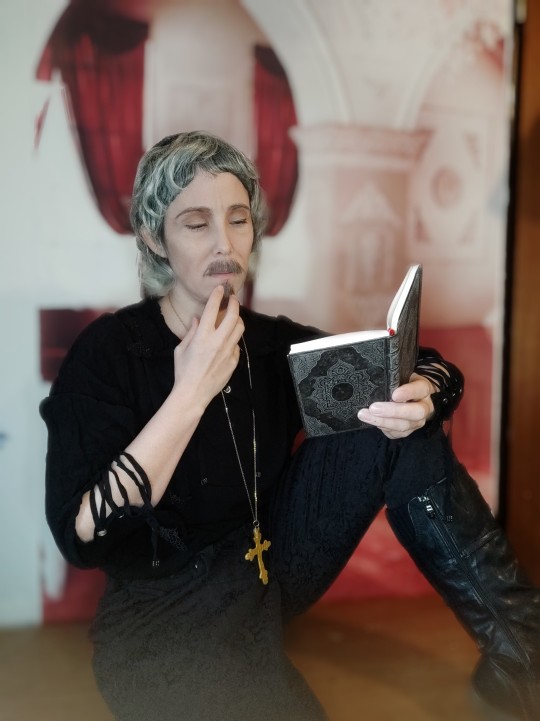
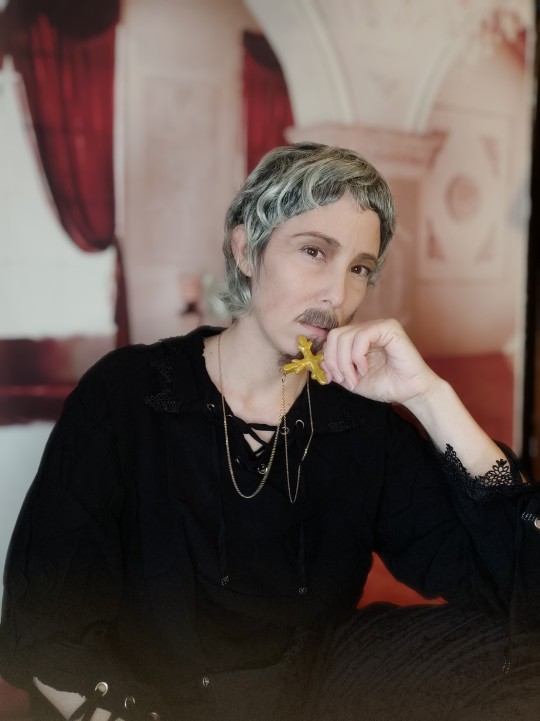

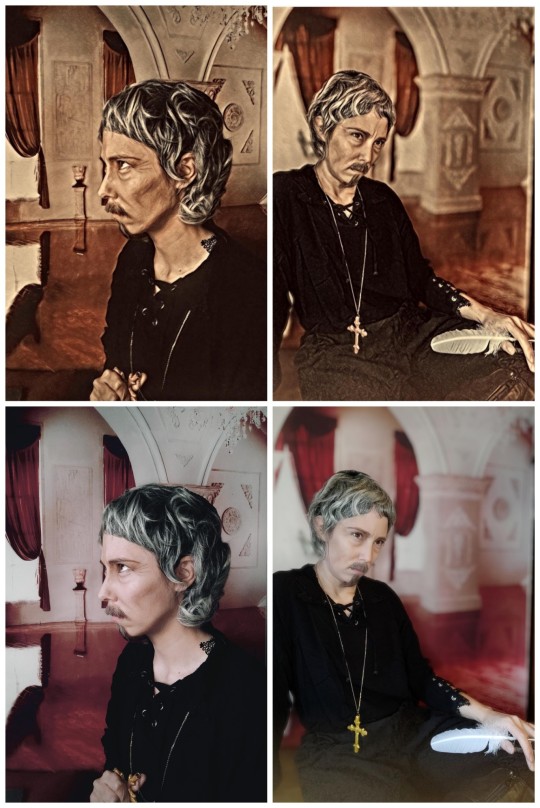


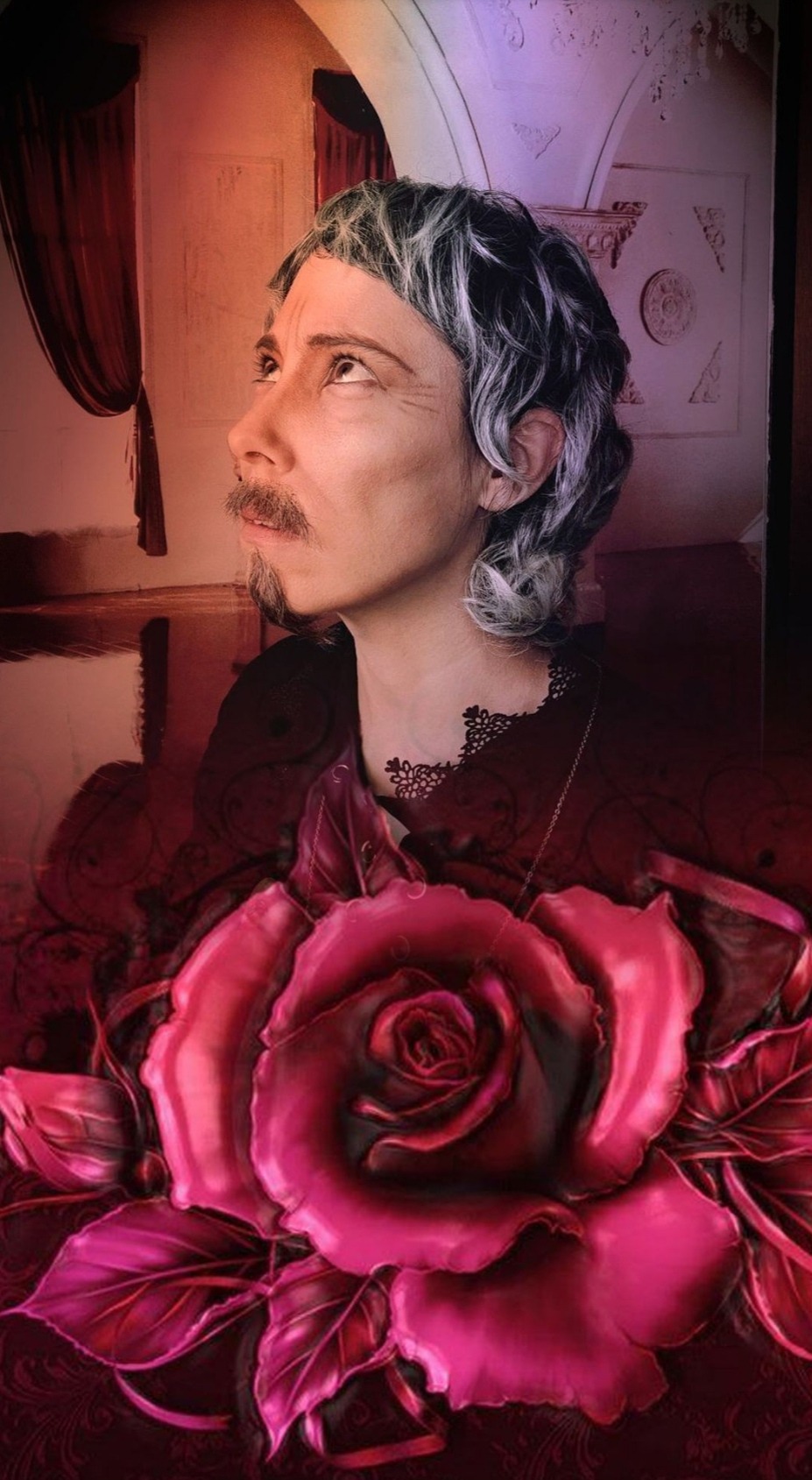
1 note
·
View note
Text
Cutwork

A needlework technique in which portions of a textile, typically cotton or linen, are cut away and the resulting hole is reinforced and filled with embroidery or needle lace. There are degrees of cutwork, ranging from the smallest amount of fabric cut away (Renaissance cutwork) to the greatest (Reticella cutwork) and Richelieu cutwork in the middle.
1 note
·
View note
Text
Meaning of the latin word base word uplet

MEANING OF THE LATIN WORD BASE WORD UPLET FREE
In truththat the red simar which occupied the wonted place Her enemies within her frontiers - all proved the great Nobles returning to their former turbulence and insolence FranceĮnfeebledthe authority of her sovereign contemnedher It wasalas! the ghost of former greatness. Of Cardinal Richelieu lingered still in his accustomed Guards upon the landing-placehave fancied that the shade Silence of the ante-chambers and the measured paces of the Mightin the solitude of that apartmentcombined with the Or who gazed on that pale browbent in anxious meditation Simar - the gorgeous robe of office - and the rich lace The lonely tenant of the roomwhich was illumined grandlyĪny one who happened at that moment to contemplate that red Great logs of oak blazed and crackled on the polished brassĪndirons whose flicker shone upon the superb habiliments of Behind thisįigure glowed a vast fireplace alive with leaping flames Table which was covered with letters and papers. Head supported on his handsleaning over a gilt and inlaid The Palais Cardinala man was sitting in deep reveriehis In a splendid chamber of the Palais Royalformerly styled Its root word is the Latin “actus.”ġ.A root word is the primary form of a word while a base word is a word that can stand on its own.Ģ.A root word may or may not have a meaning while a base word has a meaning on its own.ģ.New words can be formed using root words and base words by adding suffixes or prefixes, and several affixes can be added to root words for it to have a meaning.Ĥ.A root word is the basic linguistic unit, and it is the original form of a word while a base word is a word in its simplest form.Ebook in formato Kindle (mobi) - Kindle File Ebook (mobi) Formato per Iphone, Ipad e Ebook (epub) - Ipad, Iphone and Ebook reader format (epub) Versione ebook di powered by Adding the prefix “counter” would form the new word “counteract” which has an opposite meaning to the base word. The word “act” is a stem word which is also a base word as it can stand on its own. They form the base of other words which are created after affixes are added. Root words and base words are stem words. It can be further modified by adding the suffix “ist” which means “doer” in order to form the word “cyclist” which means “one who rides a bicycle.” Its root word is the Greek word “kyklos” which means “disk, wheel, or ring” which in turn evolved into the Latin “cyclus” then the Middle English “cicle.” It means “wheel.” And if the prefix “bi” is added, it forms the word “bicycle” which means “two wheels.” It can be modified by adding suffixes and prefixes to form new words with related meanings although it can have a meaning on its own. It is a word that is easily apparent in every language and is a word in its simplest form. Root words are parts of a base word.Ī base word is a word that does not have any other words added either at the beginning or its ending. The meaning of a word can be easily determined if one knows the root word. In words that have two or more syllables, there is a root word and two or more prefixes or suffixes. It may come from several different languages like Greek and Latin.Īffixes are usually added to root words in order to create new words. It is the term that a certain word comes from originally and is a word’s basic linguistic unit. Free morphemes are words that can stand alone or that can appear with other words while bound morphemes are prefixes and suffixes that appear with other morphemes to form a word.Ī root word may be a word that has a meaning or one that does not have a meaning.
MEANING OF THE LATIN WORD BASE WORD UPLET FREE
When combined with other words, it can form new words that may or may not have similar meanings as the original word which can either be a root word or a base word.Ī root word is the primary form of a word which can either be free morphemes or bound morphemes. In its simplest form, it can have a definite meaning.

0 notes
Photo
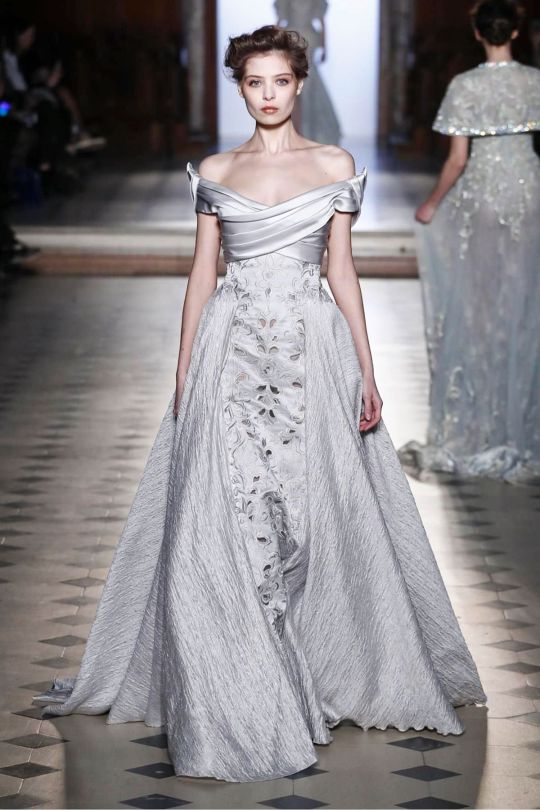

Tony Ward Couture, Spring / Summer 2017.
66 notes
·
View notes
Photo

La Mode nationale, no. 28, 17 juillet 1897, Paris. No. 11. Carré en guipure richelieu. Bibliothèque nationale de France
#La Mode nationale#19th century#1800s#1890s#1897#periodical#fashion#pattern#lace#guipure#Bibliothèque nationale de France#richelieu
17 notes
·
View notes
Note
I know he's a stick man and a bastard but he's honestly so cute 🥺 look at him in his frills and lace. Not super handsome, not a good lay, not a good person, but 😩👌
— Émilie explaining to Richelieu why she's moving to Cirey in 1733
6 notes
·
View notes
Text
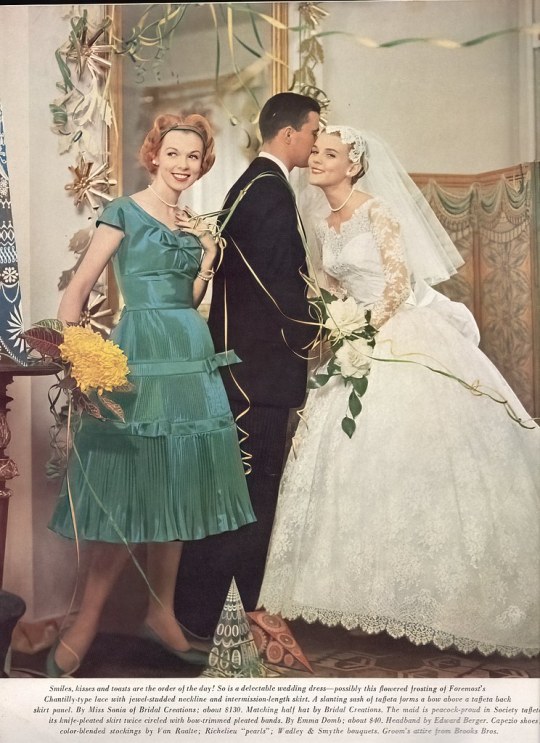
💕Bride's Magazine editorial shot by Roger Prigent 1958
The Chantilly lace and taffeta wedding dress is designed by Miss Sonia of Bridal Creations.
The bridesmaid wears a green taffeta pleated dress by Emma Domb. Headband in Edward Berger's hair, Capezio pumps. Bouquets of flowers from Wadley & Smythe.
Color-blended stockings by Van Raalte; Richelieu "pearls"
#bride's magazine#wedding dress#chantilly lace chiffon#taffeta dress#~#emma domb#sonia bridal creations#edward berger#Wadley & Smythe#van raalte stockings#fashion 50s#marriage 50s#capezio#bridesmaids#1958#life style 50s#roger prigent
20 notes
·
View notes
Text
Long post ahead! I'm so sorry if it takes ages to scroll through it, I honestly don't know how to hide text and make it less annoying for everyone who is not interested in stupid outdated things my brain comes up with at 4 am.

After the tragedy, Athos doesn't go to Paris, but joins the army under the command (well, let's say) de Crequi. Of course, our Comte went there in search of death, but (perhaps precisely thanks to the reckless courage dictated by the death wish) his commander saw potential in him and Athos quickly became an officer and personal confidant.
After a successful battle, in which Athos, against his will, earned himself the glory of a hero, de Crequi sent him to Paris with a letter to the king and also to convey to his Majesty the trophies and banners captured from the enemy.
Meanwhile, in the palace, Porthos was extremely busy being bored out of his mind and feeling like a part of furniture. Therefore, when a nobleman in dusty travel clothes entered the palace with a firm and confident step, Porthos became curious. Mostly because the man was someone new and so unlike other courtiers, covered in lace and jewelry from head to toe.
Hearing Richelieu read a letter from de Crequi to the king, in which he described not only the battle, but also the role that the newcomer played in it, Porthos involuntarily felt respect for the man and even to some extent admiration.
The king of course rejoiced like a child in "his" triumph and therefore, as a reward, asked the Comte to stay at court "to rest from the war and enjoy the company of his majesty." The Comte said his gratitude and accepted the king's invitation, but from his place Porthos could see the expression of sincere horror in the poor man's eyes as he bowed. The emotion was so strong and pure that Porthos could hardly restrain himself from laughing.
Soon, watching the Comte became Porthos' main entertainment while on duty.
Porthos laughs again watching Athos' reaction to women's flirting - a mixture of embarrassment, a sincere misunderstanding of why he became the object of attention, attempts to be polite and horror as if he was given a smoking barrel of gunpowder to handle.
Porthos nods approvingly as the Comte, with cold sarcasm, brought to heel a group of nobles who wanted to choose him as a target for their venomous remarks.
Porthos almost claps his hands with pride when the Comte challenges one of those nobles (some duke or marquis or something) to a duel, who then doesn't appear at court for weeks due to his defeat and injury.
And if Porthos enjoys observing the Comte's elegant movements as he dances and his posture and strength as he rides his magnificent black horse while hunting ... well, Porthos is just honest enough to appreciate a good skill when he see one...yeah...
On one particularly hot day, when his own leather uniform turned into a red-hot instrument of torture and Porthos was horrified to realize that the world was gradually beginning to grow blurry, he was surprised to find in his hands very wet handkerchief with the initials O.A.F on it to wipe his flaming face and cool down at least a little bit. And if Porthos always carried the handkerchief with him, then this is only in order to return it to its owner at the first opportunity ... But opportunity arose almost on every watch, but the handkerchief stubbornly stayed in his pocket and was a constant reminder that for the Comte, Porthos was not a piece of furniture. That felt nice.
And he is not speaking about the man far too often, shut up Aramis! Porthos is just grateful!
Therefore, when, while patrolling the garden on his night watch, he accidentally overheard how the duke/marquis/or something who had recovered from his defeat in a duel, but felt humiliated, plans to take revenge on the Comte and prepares an attempt on his life, Porthos cannot stand aside - a duel is a matter of honor, but planning an ambush in some dark alley to stab him in the back... it's a murder, dishonorable, disgusting and cowardly.
And if Porthos at that very moment decided to help the Comte, it was purely due to his sense of honor and justice, and not at all because of the overwhelming desire to protect him and the fear of never seeing his sharp and bright beautiful eyes across the hall full of courtiers...
#athos#the musketeers#porthos#athos/porthos#sorry#i just wanted a love story at court#with long glances#treasured handkerchiefs#gorgeous mysterious comte#and brave overprotective Porthos being romantic but refusing to admit it#re watching the musketeers was a mistake#i admit it#bad english#as usual
2 notes
·
View notes
Text

A French fashion plate circa 1860 featuring bonnets and corset covers numbered 1 through 9. It appears to be from the same magazine as the other print I bought it with, or at least the same publisher. The seller claimed they were originals. The text reads:
Imp. L’amoureux
LE MONITEUR DE LA MODE
Modèles de Lingerie de Mme Guillaume 79 rue Richelieu
358^bis
Paris, rue Richelieu 92
English translation:
Amorous Printers (or Printing)
THE MONITOR OF FASHIONS
Models of lingerie by Madame Guillaume, 79 Richelieu street
358^bis
92 Richelieu street, Paris.
[Image ID: from left to right, top to bottom, numbered as they appear in the image. All bonnets are modeled in profile.
#1: White bonnet trimmed with horizontal gold striped ribbon, many dark green leaves, two large pink roses, two red buds, and two white and orange flowers. Ribbon trails down the wearer’s back.
#2: White corset cover with collar, closure, and bottom edge trimmed with pleated light blue ribbon with circular pattern, followed by two layers of scalloped circular eyelet lace and tied with three small, dark blue bows.
#3: White bonnet with vertical light pink stripes trimmed at the bottom edge with a wide, ruched light pink ribbon. All edges are trimmed with several layers of ruched lace, the side is decorated with a light pink bow at the temple. Ribbon trails down the wearer’s back.
#4: White bonnet made of layers of lace, trimmed with purple ribbon, with two ruched bows of the same. A matching purple ribbon with black lace inlay trials down the wearer’s back.
#5: White corset cover trimmed at collar and closure with two bands of thin, pleat pink ribbon with ruched lace in between and fastened with four pink bows of descending size.
#6: White bonnet of scalloped lace trimmed with alternating loops of wide black and ultramarine ribbon, each surrounded by further lace. Black ribbons end at the side and fall to the wearer’s shoulders, ultramarine ribbons end at the center back and trial down the back.
#7: White sleeve with cuffs of two layers of transparent dotted lace with scalloped edges with circular eyelets. Draw string of thin purple ribbon tied in a bow.
#8: White corset cover decorated at collar and cuffs with broad sheet of lace with triangular and floral patterns, tapering towards the waist.
#9: White sleeve with cuff trimmed with a draw string of thin, light pink ribbon followed by two layers of lace, between which are small bows of the same ribbon. End ID]
Obviously I love image 1 so much I made it my profile picture. I’m not sure if these sleeves are optional additions to the corset covers or to a chemise not pictured here. Rue Richelieu was a very fashionable street in Victorian Paris and from which both of my new prints apparently hail.
#fashion plates#historical fashion#bonnets#fashion history#victorian fashion#image#image id#theseImageIDsTakeSoLongToWrite#corset cover
16 notes
·
View notes